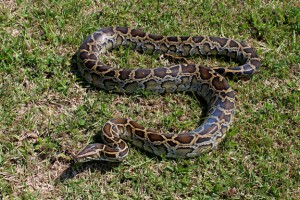

History
Burmese pythons are not native to Florida. In fact, they’re not native to the United States at all. Burmese pythons, as the name suggests, are from Southeast Asia (which includes Burma). They were first noticed in the Everglades in the 1980’s.
It is thought that these animals were introduced into the wilds of Florida when irresponsible pet owners released snakes they could no longer care for. Unfortunately, over time this led to a huge explosion of wild pythons. Although they are very hard to count since they are hard to spot, researchers estimate anywhere from 30,000 to 300,000 Pythons currently live wild in Florida.
What’s the big deal?
Burmese pythons are huge and can grow to upwards of 23 feet long and 200 pounds! Since the Everglades are such a special area ecologically, any change in the habitat or the residents can cause widespread change to the eco-system. This area houses rare exotic animals native to Florida that need protection from extinction.
Yet these same rare exotic animals can become food to a hungry python. Pythons are known to feast on pretty much anything. They eat birds, rodents, deer, raccoons, other snakes and even alligators or crocodiles.
The great python hunt
Although most of the wild pythons are found in the Everglades, there have been confirmed python sightings in Brevard County, Volusia County, Orange County, Polk County and Indian River County. This means the Florida habitat in our area is suitable for python life and they can easily start building a larger population here. This also means our pets can become prey.
In an effort to help curb the python population, Florida’s Fish and Wildlife Commission organized a python hunt. More than 1500 people signed up to help hunt and remove these dangerous reptiles from the Everglades. Unfortunately, only 68 of the snakes were caught.
The issue is that these snakes are notoriously difficult to spot. Hunters probably came within a few feet of the snakes without noticing they were there. Only the most experienced hunters, with the most knowledge of the snakes, were able to capture them. Due to the low success rate, it is unlikely a second python hunt will be approved.
What to do if you see one?
The Florida Fish and Wildlife Commission should be notified immediately. They request that you get the GPS coordinates of the sighting or even a picture if possible. Both GPS coordinates and pictures can be captured on most smart phones. If you can’t get GPS coordinates, an address or description of the location will work. Call their Exotic Species Hotline at 888-IVE-GOT1 (888- 483-4681) or report it on their website at: IveGot1.org. The website does require registration for first time users.
